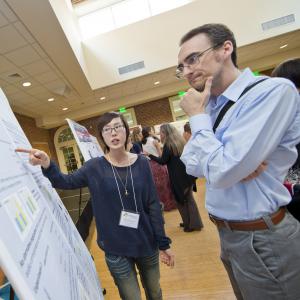Dissertation defense: Allison Johnson (HESP)
Zoom: https://go.umd.edu/lslt-zoom
Spectral contrasts produced by children with cochlear implants: Investigating the impact of signal degradation on speech acquisition
Abstract:
The primary objective of this dissertation was to assess young children’s productions of four consonants: /t/, /k/, /s/, and /ʃ/. These consonants were chosen because they comprise two place-of-articulation contrasts, which are cued auditorily by spectral information in English, and cover both early-acquired (/t/, /k/) and late- acquired (/s/, /ʃ/) manners of articulation. Thus, acquisition of these sounds is likely to be impacted by the auditory-perceptual limitations imposed by cochlear implants: because spectral information is particularly distorted, children likely have limited access to the cues that differentiate these sounds.
Twenty-eight children with cochlear implants and a group of peers with normal hearing (matched in terms of age and sex) participated in this project. The experimental task required children to repeat familiar words with initial /t/, /k/, /s/, or /ʃ/ following an auditory model and picture prompt. To create in-depth speech profiles and examine variability both within and across children, target consonants were elicited many times. Patterns of accuracy and errors were analyzed based on transcriptions, and for correct productions, centroid frequency and acoustic robustness of contrast were analyzed based on the release-burst spectra for /t/ and /k/ and the fricative noise spectra for /s/ and /ʃ/. Results showed that children with cochlear implants produced these spectral contrasts with patterns not observed in children with NH. These findings provide evidence that speech acquisition is not simply delayed due to a period of auditory deprivation prior to implantation; rather, speech acquisition is qualitatively different and may be explained by the limitations of cochlear implant speech processing algorithms.
The first chapter of this dissertation provides a general introduction. The second chapter includes a validation study for a measure to differentiate /t/ and /k/ in adults’ productions. The third chapter analyzes accuracy, errors, and spectral features of /t/ and /k/ across groups of children with and without CIs. The fourth chapter analyzes /s/ and /ʃ/ across groups of children, as well as the spectral robustness of both the /t/-/k/ and the /s/-/ʃ/ contrasts across adults and children. The final chapter discusses future directions for research and clinical applications for speech-language pathologists.
Committee members:
Dr. Jan Edwards, Chair
Dr. Rochelle Newman
Dr. Matthew Goupell
Dr. Margaritis Fourakis
Dr. Stefanie Kuchinsky
Dr. Catherine Carr, Dean’s Representative













